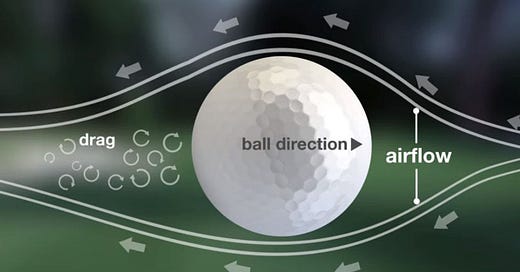“Sometimes you have to lose to win” - Nick Holliday
When understanding hockey and life, we can all agree that adversity is a vital ingredient. If you think back to your biggest personal growth moments, there is no doubt that many of them were attached to adversity faced along the way.
For example, the 2018-19 Tampa Bay Lightning were the best team in the regular season by a country mile and then lost in a dramatic (yet anti-climatic) four-game sweep at the hands of the Columbus Blue Jackets. This season, they stormed back and won the Stanley Cup.
Caddyshack
In the classic movie Caddyshack, Chevy Chase’s character gives advice to his caddy:
There’s a force in the universe that makes things happen. All you have to do is get in touch with it. Stop thinking… let things happen… and… be the ball.
Before we can be the ball, we need to know more about the ball.
The Guttie
The modern-day golf ball was introduced in the 1840s by Robert Adams Paterson. He created the first molded golf ball with Gutta-perchaa tree sap that hardened after being heated. This ball was called The Guttie. It performed better, was more durable, and was eventually cheaper to manufacturer. It was a major contributor in helping golf become more popular.
Creating perfect roundness in those days was almost impossible, but was nonetheless considered something desirable. The affluent would heat to remold their balls or acquire more once theirs were nicked.
Those who weren’t fortunate enough to purchase more well-rounded golf balls began to observe that the more their ball got nicked up, the better its performance. The ball would go further and have a better flight characteristics.
The reason? Although seen as imperfections, the nicks actually helped the ball’s aerodynamics. Those little nicks actually enhance the golf ball.
Dimples & Aerodynamics
What you need to know is that a smooth ball creates a large wake (low-pressure area) as it flies through the air. This large wake sucks the ball backward (commonly known as drag).
How and when air detaches from the ball makes all the difference when attempting to increase performance.
Today, those nicks are now purposefully etched into the golf ball as dimples. Dimples create turbulence that allows the golf ball’s wake to become lessened by having the air cling to the ball’s surface longer.
(For nerds only - There are two types of airflow — laminar (uniform and aligned) and turbulent (unpredictable). Laminar creates less drag by itself but is vulnerable to separation and thus creating tremendous drag. Turbulent flow itself creates more drag but is less vulnerable to separation. Separation creates wake/drag in aerodynamics.)
Relating this to hockey (and life)
Acquiring translatable skills. No adversity = limited growth
Think about a player who has always been a faster skater than his/her peers. While fast skating is an enviable skill to have, it often leads players to over-rely on their speed and under-develop their other skills. This often leads to omitting the requisite problem-solving skills that allow a player to perceive their surroundings quickly.
As a coach, often times the hardest players to grow are those who overuse a skill. A player that is faster understands the success that comes with using that speed and becomes over-reliant on using that speed. They aren’t compelled to battle through traffic, problem solve in tight situations, or find ways to create space with their hockey IQ.
Convincing them to use other skills becomes a challenge. Often the player is wondering why they need to change if they are having so much success, only to realize down the road that they need the other skills to have success higher up the hockey pyramid. This is one reason that many late bloomers end up going farther than players that “arrive” earlier.
Adversity is helpful to performance
Every situation and person can be a learning opportunity. Did you like what that person did? Do that. Did you dislike how a situation went? Change something.
At the University of Akron, head coach Matt Koch (“Cookie”) has a simple mistake protocol for when players (and coaches) inevitably ‘mess up'.
Admit the mistake
Apologize for the mistake
Learn from the mistake
Press on
I’ve talked to many business owners that virtually exclusively hire former team sport athletes because they know they’re able to coach those employees without much difficulty. They’ve dealt with adversity before and realize it makes them better.
Parent hack - Let players gain experience with failure and fighting their own battles. For example, talking with coach about ice time or how to improve or get on the PP/PK.
Be the ball
Dimples create turbulence, yet allows the ball to go further.
Adversity creates turbulence, yet allows people/players to go further.
While no one wishes for adversity, give a gentle nod and appreciate adversity when it comes your way. Let things happen and… be the ball.
Further Reading - Mental frameworks and tools
Did You Enjoy This Newsletter?
Help us spread the ideas within and share it with the people you care about





